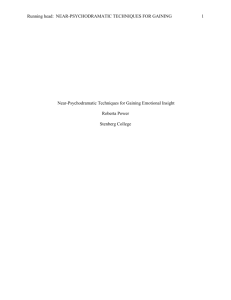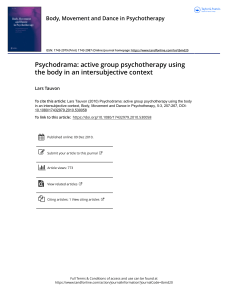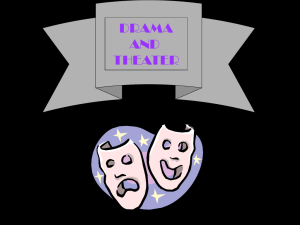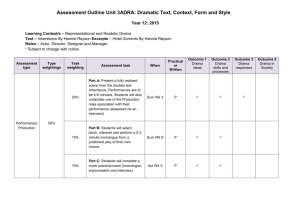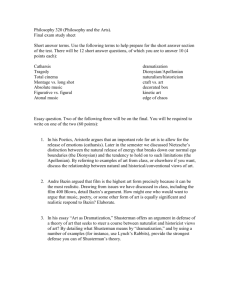introduction-psychod..
advertisement
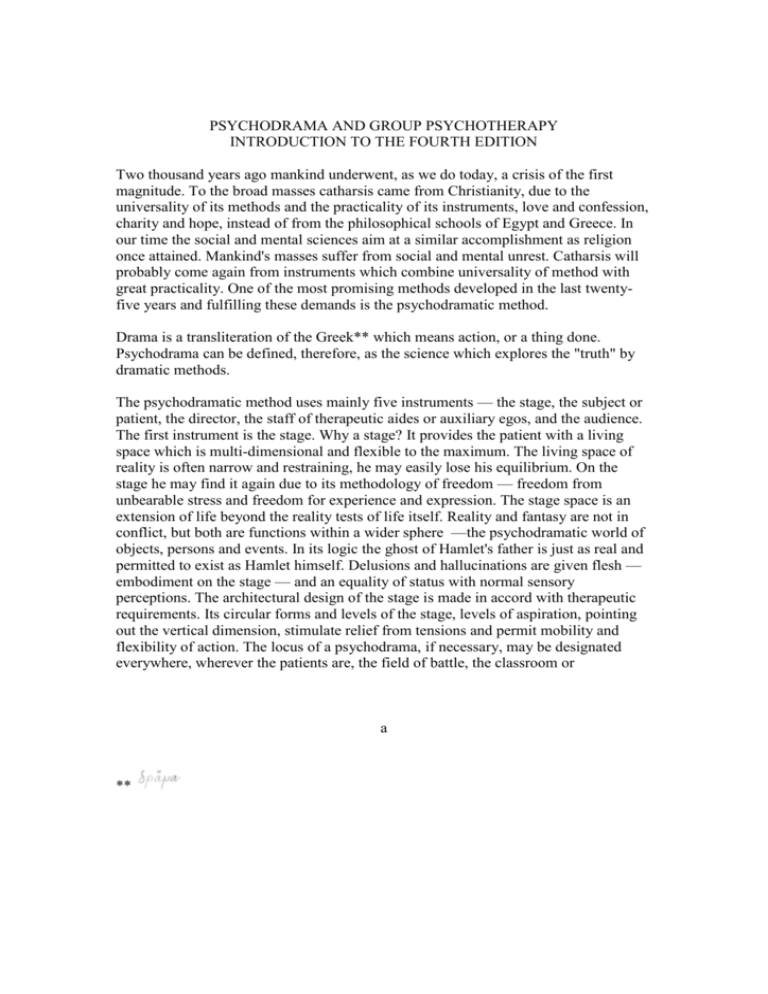
PSYCHODRAMA AND GROUP PSYCHOTHERAPY INTRODUCTION TO THE FOURTH EDITION Two thousand years ago mankind underwent, as we do today, a crisis of the first magnitude. To the broad masses catharsis came from Christianity, due to the universality of its methods and the practicality of its instruments, love and confession, charity and hope, instead of from the philosophical schools of Egypt and Greece. In our time the social and mental sciences aim at a similar accomplishment as religion once attained. Mankind's masses suffer from social and mental unrest. Catharsis will probably come again from instruments which combine universality of method with great practicality. One of the most promising methods developed in the last twentyfive years and fulfilling these demands is the psychodramatic method. Drama is a transliteration of the Greek** which means action, or a thing done. Psychodrama can be defined, therefore, as the science which explores the "truth" by dramatic methods. The psychodramatic method uses mainly five instruments — the stage, the subject or patient, the director, the staff of therapeutic aides or auxiliary egos, and the audience. The first instrument is the stage. Why a stage? It provides the patient with a living space which is multi-dimensional and flexible to the maximum. The living space of reality is often narrow and restraining, he may easily lose his equilibrium. On the stage he may find it again due to its methodology of freedom — freedom from unbearable stress and freedom for experience and expression. The stage space is an extension of life beyond the reality tests of life itself. Reality and fantasy are not in conflict, but both are functions within a wider sphere —the psychodramatic world of objects, persons and events. In its logic the ghost of Hamlet's father is just as real and permitted to exist as Hamlet himself. Delusions and hallucinations are given flesh — embodiment on the stage — and an equality of status with normal sensory perceptions. The architectural design of the stage is made in accord with therapeutic requirements. Its circular forms and levels of the stage, levels of aspiration, pointing out the vertical dimension, stimulate relief from tensions and permit mobility and flexibility of action. The locus of a psychodrama, if necessary, may be designated everywhere, wherever the patients are, the field of battle, the classroom or a ** the private home. But the ultimate resolution of deep mental conflicts requires an objective setting, the therapeutic theater. Like in religion, although the devout may pray to his God in his own chamber, it is in the church where the community of believers attain the most complete confirmation of their faith. The second instrument is the subject or patient. He is asked to be himself on the stage, to portray his own private world. He is told to be himself, not an actor, as the actor is compelled to sacrifice his own private self to the role imposed upon him by a playwright. Once he is warmed up to the task it is comparatively easy for the patient to give an account of his daily life in action, as no one is as much of an authority on himself as himself. He has to act freely, as things rise up in his mind; that is why he has to be given freedom of expression, spontaneity. Next in importance to spontaneity comes the process of enactment. The verbal level is transcended and included in the level of action. There are several forms of enactment, pretending to be in a role, reenactment or acting out a past scene, living out a problem presently pressing, creating life on the stage or testing oneself for the future. Further comes the principle of involvement. We have been brought up with the idea that, in test as well as in treatment situations, a minimum of involvement with other persons and objects is a most desirable thing for the patient. An illustration of this is the "Rorschach." The Rorschach situation is reduced to ink blots. In the Rorschach the subjects change but the situation is always the same. It is thought to be its greatest virtue that it is pure and therefore offers an "objective" test. The psychoanalytic interview in its orthodox form too, tried to be pure and objective, by reducing the involvement with the analyst to a minimum. In the psychodramatic situation a maximum of involvement with other subjects and things is not only possible but expected. Reality is not only not feared but provoked. Indeed, in the psychodramatic situation all degrees of involvement take place, from a minimum to a maximum. In addition comes the principle of realization. The patient is enabled not only to meet parts of himself, but the other persons who partake in his mental conflicts. These persons may be real or illusions. The reality test which is a mere word in other therapies is thus actually made true on the stage. The warming up process of the subject to psychodramatic portrayal is stimulated by numerous techniques, only a few of which are mentioned here: self presentation, soliloquy, projection, 'interpolation of resistance, reversal of roles, double ego, mirror techniques, auxiliary world, realization and psycho-chemical techniques. The aim of these sundry techniques is b not to turn the patients into actors, but rather to stir them up to be on the stage what they are, more deeply and explicitly than they appear to be in life reality. The third instrument is the director. He has three functions: producer, therapist and analyst. As producer he has to be on the alert to turn every clue which the subject offers into dramatic action, to make the line of production one with the life line of the subject, and never to let the production lose rapport with the audience. As therapist attacking and shocking the subject is at times just as permissible as laughing and joking with him; at times he may become indirect and passive and for all practical purposes the session seems to be run by the patient. As analyst he may complement his own interpretation by responses coming from informants in the audience, husband, parents, children, friends or neighbors. The fourth instrument is a staff of auxiliary egos. These auxiliary egos or therapeutic actors have a double significance. They are extensions of the director, exploratory and therapeutic, but they are also extensions of the patient, portraying the actual or imagined personae of their life drama. The functions of the auxiliary ego are threefold: the function of the actor, portraying roles required by the patient's world; the function of the therapeutic agent, guiding the subject; and the function of the social investigator. The fifth instrument is the audience. The audience itself has a double purpose. It may serve to help the patient or, being itself helped by the subject on the stage the audience becomes the patient. In helping the patient it is a sounding board of public opinion. Its responses and comments are as extemporaneous as those of the patient, they may vary from laughter to violent protest. The more isolated the patient is, for instance because his drama on the stage is shaped by delusions and hallucinations, the more important becomes, to him, the presence of an audience which is willing to accept and understand him. When the audience is helped by the subject, thus becoming the patient itself, the situation is reversed. The audience sees itself, that is, one of its collective syndromes portrayed on the stage. The stage portion of a psychodramatic session has opened the way to action research and action therapy, role test and role training, situation tests and situational interviews whereas the audience portion has become the common ground of the better known forms of group psychotherapy, as lecture methods, dramatic methods and film methods. Scientific foundations of group psychotherapy require as a prerequisite a basic science of human relations, widely known as sociometry. It is from "sociatry," a pathological counterpart of such a science that knowledge can be derived as to abnormal c organization of groups, the diagnosis and prognosis, prophylaxis and control of deviate group behavior. Now that we have described the five basic instruments required to run a psychodramatic session we may ask ourselves: to what effect? We will limit ourselves here to the description of a single phenomenon, mental catharsis (stems from the Greek, it means purging, purification). Breuer and Freud were ignorant of the psychotherapeutic implications of the drama milieu to which Aristotle referred. It remained for psychodrama to rediscover and treat the idea of catharsis in its relation to psychotherapy. We picked up the trend of thought where Aristotle had left off. We too, began with the drama but reversed the procedure. It was not the end phase but the initial phase of the drama towards which we directed attention. Mental catharsis was when we entered the scene with our investigations to be found only in dramatic literature, in faded memories of Aristotle's old definition and the term itself practically out of circulation. The psychoanalysts, after a flare up in the early 1890's had pushed it aside. As practically every human activity can be the source of some degree of catharsis the problem is to determine in what catharsis consists, in which way it differs for instance, from happiness, contentment, ecstasy, need satisfaction, and so forth, and whether one source is superior in the production of catharsis to another source; indeed, whether there is an element common to all sources which operates in the production of catharsis. Therefore my aim has been to define catharsis in such a way that all forms of influence which have a demonstrable cathartic effect can be shown as positive steps within a single total process of operation. I discovered the common principle producing catharsis to be: spontaneity. Because of the universality of the act and its primordial nature it engulfs all other forms of expression. They flow naturally out of it or can be encouraged to emerge, verbal associations, musical associations, visual associations, color associations, rhythmic and dance associations, and every other stimulus which might arouse or inhibit the emergence of one or another factor, for instance, the use of psychochemical starters like sedatives, as barbiturates, sodium amytal, sodium pentotal; or shock methods as insulin, metrazol or electricity; or endocrinological medications as thyroid are fully within the scheme of total catharsis; they may condition and prepare the organism for psychodramatic integration. The need for the drama can be temporarily choked, for instance, by sleep or shock therapies. But the fundamental need for the realization of certain fantastic imageries can not be "shocked away." Unless the subject is reduced to a brain in- d valid by surgery or prolonged shock treatments, the temporarily scared patient is bound to relapse and reproduce the same type of mental syndrome he had before treatment began. It is into the stream of action catharsis that all the rivulets of partial catharsis flow. The treatment of audiences has become an important alternative to individual treatment. The relationship of the audience to itself in a psycho- dramatic session, being treated by its own spokesman on the stage, gives us a clue as to the reasons of the cathartic effect of psychodrama. According to historians of the Greek drama the audience was there first, the chorus, musing about a common syndrome. There were "keynoters" among them but they remained within the chorus. Thespis is credited with having put the first actor upon a social space outside of the chorus, the stage, not speaking to them, but portraying the woes of their own hero. Aeschylos is credited with having put the second actor on the stage, thus making possible the dialogue and interaction of roles. We may be credited to have .put the psyche itself on the stage. The psyche which originally came from the group—after a process of reconversion on the stage—personified by an actor—returns to the group—in the form of the psychodrama. That which was most startling, new and spectacular to see and to feel on the stage appears to the participants after thorough exposure as a process which is familiar to them and intimately known—as their own selves. The psychodrama confirms their own identity as in a mirror. e From: J.L. Moreno, Psychodrama, First Volume, Fourth Edition with New Introduction, Beacon House Inc. Beacon N.Y. 1977


